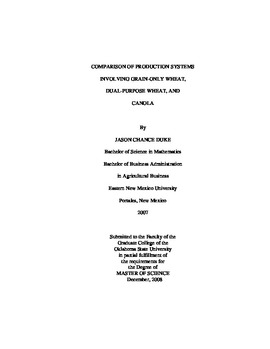| dc.contributor.advisor | Epplin, Francis | |
| dc.contributor.author | Duke, Jason Chance | |
| dc.date.accessioned | 2014-04-15T19:52:36Z | |
| dc.date.available | 2014-04-15T19:52:36Z | |
| dc.date.issued | 2008-12-01 | |
| dc.identifier.uri | https://hdl.handle.net/11244/8675 | |
| dc.description.abstract | This study consisted of two papers. The research reported in the first paper was conducted to determine if a crop rotation that includes winter hardy canola and winter wheat is economically competitive with continuous monoculture winter wheat in Oklahoma. A phone survey of producers that have experience producing both wheat and canola was conducted. Yield distributions were used in combination with cost estimates to simulate expected net returns for each of four production systems: continuous grain-only wheat; continuous dual-purpose (fall-winter forage plus grain) wheat; canola followed by two crops of grain-only wheat; and canola followed by two years of dual-purpose wheat. The research reported in the second paper was conducted to determine distributions of expected net returns for grain-only wheat; dual-purpose wheat stocked with steers with an initial weight of 450 pounds; and dual-purpose wheat stocked with steers with an initial weight of 550 pounds. A phone survey of Oklahoma producers that have experience producing both dual-purpose wheat and grain-only wheat was conducted to obtain distributions of key production parameters including grain yield and average daily gain. The production parameters were used in combination with distributions of wheat price, steer prices, and cost estimates to simulate distributions of expected net returns. A three year crop rotation that includes canola followed by two years of dual-purpose wheat generated the greatest net returns in the majority of 100 simulated growing seasons. Switching from a continuous grain-only wheat system to a canola-wheat-wheat rotation increases expected net returns on average 21.41 per acre per year. Based on the expected yields reported by growers and the simulated net returns, the canola-wheat-wheat rotation dominates continuous wheat. Simulations of net returns for grain-only wheat and dual-purpose wheat found that dual-purpose wheat stocked with steers with an initial weight of 450 (550) pounds produced greatest net returns 76 percent (22 percent) of the time. The discrepancies in findings of prior studies of the grain-yield forgone by dual-purpose relative to grain-only wheat can be explained in part by differences in planting dates. | |
| dc.format | application/pdf | |
| dc.language | en_US | |
| dc.publisher | Oklahoma State University | |
| dc.rights | Copyright is held by the author who has granted the Oklahoma State University Library the non-exclusive right to share this material in its institutional repository. Contact Digital Library Services at lib-dls@okstate.edu or 405-744-9161 for the permission policy on the use, reproduction or distribution of this material. | |
| dc.title | Comparison of Production Systems Involving Grain-Only Wheat, Dual-Purpose Wheat, and Canola | |
| dc.type | text | |
| dc.contributor.committeeMember | Peel, Derrell | |
| dc.contributor.committeeMember | Vitale, Jeff | |
| osu.filename | Duke_okstate_0664M_10139.pdf | |
| osu.college | Agricultural Sciences and Natural Resources | |
| osu.accesstype | Open Access | |
| dc.description.department | Department of Agricultural Economics | |
| dc.type.genre | Thesis | |
